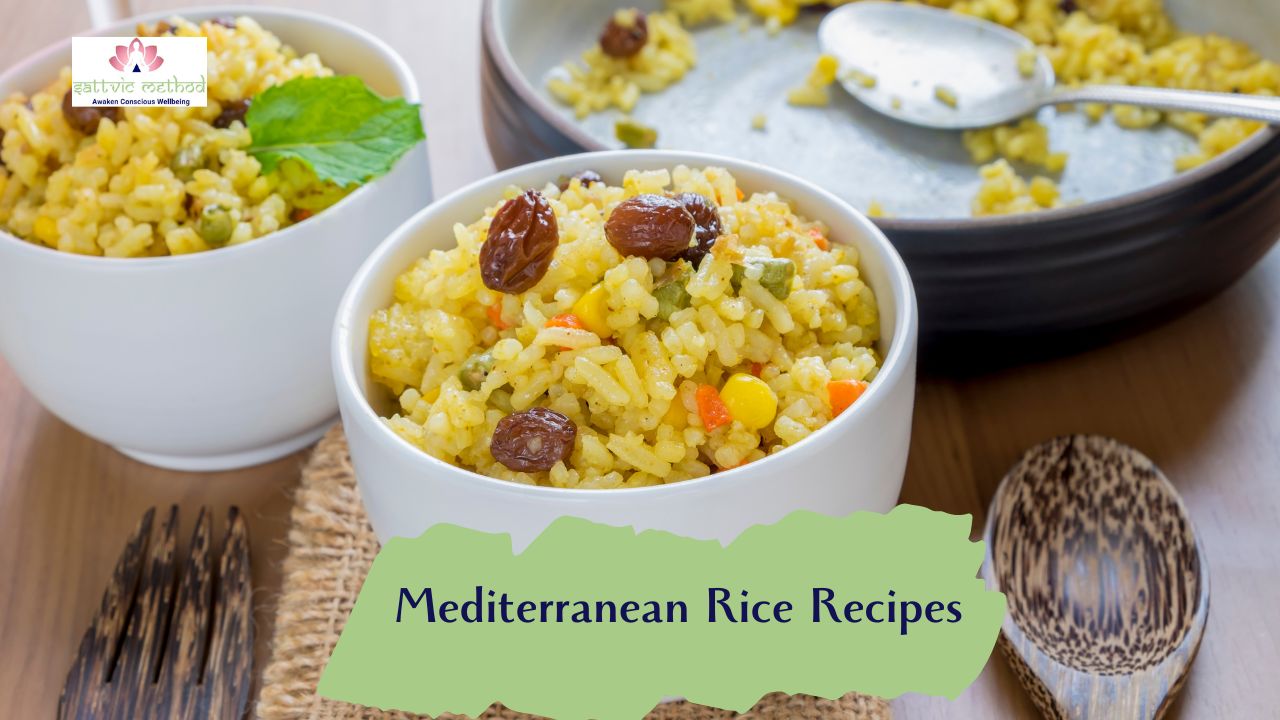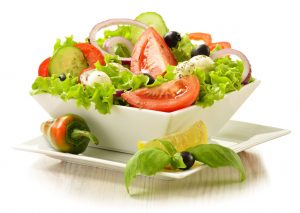Embark on a culinary journey to the heart of the Mediterranean with the exquisite flavors of Mediterranean Rice. This delectable dish combines the rich traditions and vibrant ingredients of the Mediterranean region, offering a true feast for the senses. Although traditional Mediterranean rice is made with rice, infused with aromatic herbs, succulent seafood, and a medley of fresh vegetables, this version is suitable for vegans and vegetarians and has no meat. Each bite transports you to sun-drenched shores, where the sea breeze carries the scent of olive groves and citrus trees.
As you savor the harmonious blend of flavors, you’ll discover the culinary secrets that have been passed down through generations. The range of inspired vegetarian recipes such as vegetarian paella of Spain to the pilaf of Lebanon, Mediterranean Rice allows vegetarians to enjoy the diverse and captivating cuisines of this enchanting region. Whether you’re a seasoned foodie or simply seeking a taste of the exotic, let Mediterranean Rice take you on a gastronomic adventure that will leave you craving more. Get ready to indulge in a dish that captures the essence of the Mediterranean and brings it straight to your table.
A Brief History and Cultural Significance of Mediterranean Rice
Rice is not traditionally a staple in the Mediterranean diet, which primarily focuses on whole grains such as whole wheat, barley, and bulgur. However, rice has been a part of food in the Mediterranean for centuries, and its history is deeply intertwined with the region’s rich culture. The cultivation of rice can be traced back to ancient civilizations such as the Greeks and Romans, who recognized its nutritional value and culinary versatility of the rice. In ancient times, in the Mediterranean, rice was often considered a luxury ingredient, reserved for special occasions and festive feasts.
Yet, throughout history rice has played a major role in Mediterranean cuisine. Through the various preparations of rice, one can gather the diverse influences of different cultures and civilizations on the Mediterranean. For example, new spices and recipes became available during the Moorish invasion of Spain. Similarly, during the Ottoman Empire’s reign over the Eastern Mediterranean, new flavors and techniques were added to the region’s culinary traditions. To read more about the interesting history of Ottoman era cuisine in this in-depth article. All this has resulted in a fascinating fusion of flavors that is unique to the Mediterranean region today.
Traditional Mediterranean Rice Dishes
One of the most iconic and beloved Mediterranean rice dishes is paella, originating from the sunny shores of Spain. This vibrant and aromatic dish is a celebration of local ingredients, featuring a combination of saffron-infused rice, seafood, and a medley of vegetables. The flavors of paella vary from region to region and are made further diverse with each cook adding their own personal touch. Because the Sattvic Method does not use any meat, all recipes on this page will include only vegetarian options.
Another classic Mediterranean rice dish is pilaf, which originated in the Middle East and spread throughout the Mediterranean. Pilaf is a versatile preparation method that can be adapted to a variety of ingredients, making it a popular choice for both everyday meals and festive gatherings. It typically involves cooking rice in a seasoned broth, often with the addition of meat, vegetables, and aromatic spices. The Sattvic Method does not use any meat in their recipes, thus all recipes will be modified to be suitable for vegetarians.
Ingredients Commonly Used in Mediterranean Rice Recipes
The key to the exquisite flavors of Mediterranean rice lies in the quality and selection of ingredients. Like the tropical region, the Mediterranean region is also blessed with an abundance of fresh produce, seafood, and aromatic herbs, all of which form the building blocks of these delicious dishes.
When it comes to choice of rice, short-grain varieties such as Arborio and Valencia are commonly used in Mediterranean recipes. These varieties have a higher starch content, which contributes to the creamy texture and rich flavor of the final dish. However, you can use low starch varieties such as long grain rice and still enjoy the taste and flavor of the recipes. Saffron, a prized spice, is often used to add a vibrant yellow hue and a subtle floral note to Mediterranean rice.
Health Benefits of Mediterranean Rice
In addition to its delightful taste, Mediterranean rice offers a range of health benefits. The Mediterranean diet has long been praised for its positive effects on overall well-being, and rice is a key component of this wholesome eating pattern.
Rice is naturally gluten-free, making it a suitable choice for individuals with gluten sensitivities or celiac disease. It is also low in fat and cholesterol, making it a heart-healthy option. The high fiber content of rice aids in digestion and helps maintain a healthy weight. Additionally, the Mediterranean rice dishes are often packed with vegetables and lean proteins, providing a balanced and nutritious meal. This is somewhat similar to Pongal, khichdi and other rice and beans recipes. Our cookbook on Pongal recipes features several traditional and trendy Pongal recipes.
How to Cook Perfect Mediterranean Rice
Cooking Mediterranean rice to perfection requires attention to detail and a few essential techniques. The first step is to rinse the rice thoroughly to remove any excess starch, which can cause the grains to become sticky. It is also important to choose the right ratio of rice to liquid, as this will ensure that the grains cook evenly and absorb the flavors of the other ingredients. If you are confused about the right amount of water to add for the rice recipe of your choice, check out this calculator.
To infuse the rice with maximum flavor, a fragrant broth or stock is often used as the cooking liquid. This can be made by simmering vegetables, herbs, and spices in water or by using pre-made broths. The rice is then added to the liquid and cooked gently until tender.
Variations and Adaptations of Mediterranean Rice Recipes
Mediterranean rice dishes offer endless possibilities for customization and adaptation. Depending on your taste preferences and the ingredients you have on hand, you can create a variety of delicious variations.
For a vegetarian twist, you can replace the seafood or meat with an assortment of roasted vegetables, such as bell peppers, zucchini, and eggplant. Fresh herbs like basil, parsley, and mint can be added to enhance the aroma and freshness of the dish. You can also experiment with different spices and seasonings to create a unique flavor profile.
Pairing Mediterranean Rice with Other Dishes
Mediterranean rice is a versatile dish that pairs well with a wide range of other Mediterranean specialties. For a complete meal, serve it alongside dishes such as grilled fish, roasted chicken, or marinated lamb. The flavors of the rice complement these main courses beautifully and create a harmonious dining experience.
For a lighter option, Mediterranean rice can be enjoyed on its own as a satisfying vegetarian meal. The combination of rice, vegetables, and aromatic herbs provides a well-rounded and nutritious dish.
Popular Mediterranean Rice Recipes for Vegans
1. **Paella Vegan Valenciana**: This classic Spanish paella features a combination of tofu, jackfruit, and saffron-infused rice, cooked in a traditional paella pan. You can also make this recipe on any heavy bottom pan.
2. **Mediterranean Vegan Risotto**: This creamy and flavorful risotto is made with a variety of locally grown vegetables, such as potatoes, carrot, cabbage, peas, cauliflower, and bell pepper, and finished with a drizzle of extra virgin olive oil.
3. **Lebanese Rice Pilaf**: This fragrant pilaf is made with basmati rice, toasted vermicelli, and a blend of aromatic spices like cinnamon and allspice.
Final Thoughts
Mediterranean Rice is more than just a dish; it’s a culinary journey that takes you to the heart of the Mediterranean. With its vibrant flavors, fresh ingredients, and rich cultural heritage, this versatile dish offers a taste of the exotic that will captivate your senses. Whether you’re indulging in a traditional paella, savoring a fragrant pilaf, or experimenting with your own variations, Mediterranean Rice is sure to transport you to sun-drenched shores and leave you craving more. So, gather your ingredients, fire up the stove, and let the flavors of the Mediterranean enchant your taste buds. Bon appétit!




